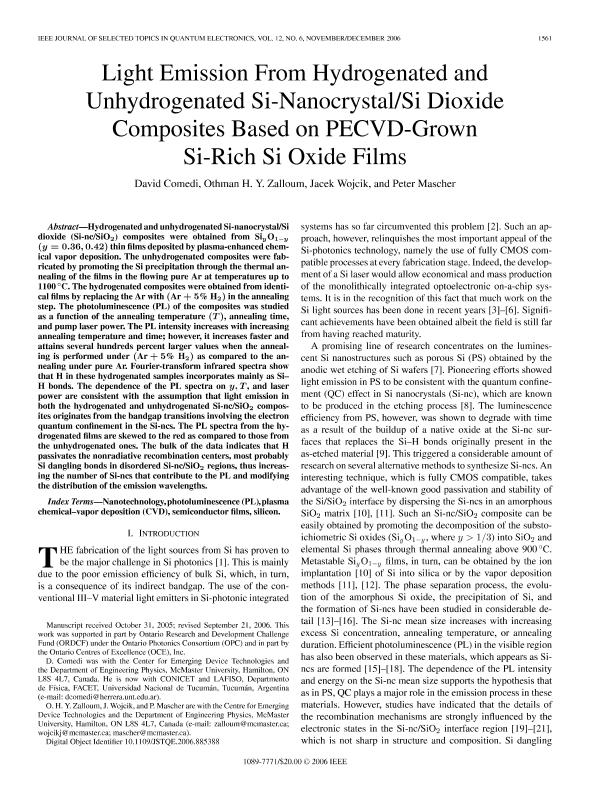Mostrar el registro sencillo del ítem
dc.contributor.author
Comedi, David Mario

dc.contributor.author
Zalloum, O. H. Y.
dc.contributor.author
Wojcik, J.
dc.contributor.author
Mascher, P.
dc.date.available
2019-10-10T14:42:44Z
dc.date.issued
2006-12
dc.identifier.citation
Comedi, David Mario; Zalloum, O. H. Y.; Wojcik, J.; Mascher, P.; Light emission from hydrogenated and unhydrogenated Si-nanocrystal/Si dioxide composites based on PECVD-grown Si-Rich Si oxide films; Institute of Electrical and Electronics Engineers; Ieee Journal Of Selected Topics In Quantum Electronics; 12; 6; 12-2006; 1561-1569
dc.identifier.issn
1077-260X
dc.identifier.uri
http://hdl.handle.net/11336/85497
dc.description.abstract
Hydrogenated and unhydrogenated Si-nanocrystal/Si dioxide (Si-nc/SiO2) composites were obtained from SiyO1-y (y=0.36, 0.42) thin films deposited by plasma-enhanced chemical vapor deposition. The unhydrogenated composites were fabricated by promoting the Si precipitation through thermal annealing of the films in flowing pure Ar at temperatures up to T=1100oC. Fourier transform infrared spectroscopy (FTIR) and elastic recoil detection analysis (ERDA) did not detect any trace of H in these samples. The hydrogenated composites were obtained from identical films by replacing the Ar with (Ar+5%H2) in the annealing step. The photoluminescence (PL) of the composites was studied as a function of the annealing temperature, annealing time and pump laser power. The PL intensity in the Ar-annealed samples increases with increasing annealing temperature, and it increases and then tends to saturation as a function of the annealing time at 1100oC. For the samples annealed in (Ar+5%H2), a qualitatively similar behavior is observed, however, the PL intensity is several hundreds percent larger. The FTIR spectra show that H in these samples incorporates as Si-H bonds. The analysis of the Si-H stretching band, in conjunction with results from previous studies of the Si/SiO2 phase separation process, suggests that a fraction of these bonds are located in the Si/SiO2 interface regions. The dependence of the PL spectra on y, T, and laser power are consistent with the assumption that light emission in both hydrogenated and unhydrogenated Si-nc/SiO2 composites originates from bandgap transitions involving electron quantum confinement in the Si-ncs, the details of the recombination mechanism still being unclear. The PL spectra from the hydrogenated films are skewed to the red as compared to those from the unhydrogenated ones. The bulk of the data indicates that H passivates nonradiative recombination centers, mostly probably Si dangling bonds in the Si-nc/SiO2 regions, thus increasing the number of Si-ncs that contribute to the PL and modifying the distribution of emission wavelengths. The PL intensity in the Ar-annealed samples increases with increasing annealing temperature, and it increases and then tends to saturation as a function of the annealing time at 1100oC. For the samples annealed in (Ar+5%H2), a qualitatively similar behavior is observed, however, the PL intensity is several hundreds percent larger. The FTIR spectra show that H in these samples incorporates as Si-H bonds. The analysis of the Si-H stretching band, in conjunction with results from previous studies of the Si/SiO2 phase separation process, suggests that a fraction of these bonds are located in the Si/SiO2 interface regions. The dependence of the PL spectra on y, T, and laser power are consistent with the assumption that light emission in both hydrogenated and unhydrogenated Si-nc/SiO2 composites originates from bandgap transitions involving electron quantum confinement in the Si-ncs, the details of the recombination mechanism still being unclear. The PL spectra from the hydrogenated films are skewed to the red as compared to those from the unhydrogenated ones. The bulk of the data indicates that H passivates nonradiative recombination centers, mostly probably Si dangling bonds in the Si-nc/SiO2 regions, thus increasing the number of Si-ncs that contribute to the PL and modifying the distribution of emission wavelengths.
dc.format
application/pdf
dc.language.iso
eng
dc.publisher
Institute of Electrical and Electronics Engineers

dc.rights
info:eu-repo/semantics/openAccess
dc.rights.uri
https://creativecommons.org/licenses/by-nc-sa/2.5/ar/
dc.subject
Hydrogen
dc.subject
Si nanocrystals
dc.subject
Si dioxide
dc.subject
Photoluminescence
dc.subject.classification
Física de los Materiales Condensados

dc.subject.classification
Ciencias Físicas

dc.subject.classification
CIENCIAS NATURALES Y EXACTAS

dc.title
Light emission from hydrogenated and unhydrogenated Si-nanocrystal/Si dioxide composites based on PECVD-grown Si-Rich Si oxide films
dc.type
info:eu-repo/semantics/article
dc.type
info:ar-repo/semantics/artículo
dc.type
info:eu-repo/semantics/publishedVersion
dc.date.updated
2019-09-30T20:45:19Z
dc.journal.volume
12
dc.journal.number
6
dc.journal.pagination
1561-1569
dc.journal.pais
Estados Unidos

dc.journal.ciudad
New York
dc.description.fil
Fil: Comedi, David Mario. Universidad Nacional de Tucumán. Facultad de Ciencias Exactas y Tecnología. Departamento de Física. Laboratorio de Física del Sólido; Argentina. Consejo Nacional de Investigaciones Científicas y Técnicas. Centro Científico Tecnológico Conicet - Tucumán; Argentina
dc.description.fil
Fil: Zalloum, O. H. Y.. McMaster University; Canadá
dc.description.fil
Fil: Wojcik, J.. McMaster University; Canadá
dc.description.fil
Fil: Mascher, P.. McMaster University; Canadá
dc.journal.title
Ieee Journal Of Selected Topics In Quantum Electronics

dc.relation.alternativeid
info:eu-repo/semantics/altIdentifier/doi/https://dx.doi.org/10.1109/JSTQE.2006.885388
dc.relation.alternativeid
info:eu-repo/semantics/altIdentifier/url/https://ieeexplore.ieee.org/document/4032636
Archivos asociados
